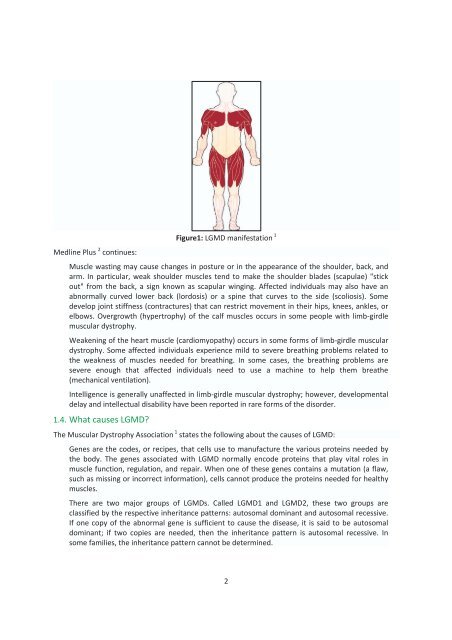You also want an ePaper? Increase the reach of your titles
YUMPU automatically turns print PDFs into web optimized ePapers that Google loves.
Medline Plus 2 continues:<br />
Figure1: <strong>LGMD</strong> manifestation 1<br />
Muscle wasting may cause changes in posture or in the appearance of the shoulder, back, and<br />
arm. In particular, weak shoulder muscles tend to make the shoulder blades (scapulae) "stick<br />
out" from the back, a sign known as scapular winging. Affected individuals may also have an<br />
abnormally curved lower back (lordosis) or a spine that curves to the side (scoliosis). Some<br />
develop joint stiffness (contractures) that can restrict movement in their hips, knees, ankles, or<br />
elbows. Overgrowth (hypertrophy) of the calf muscles occurs in some people with limb-girdle<br />
muscular dystrophy.<br />
Weakening of the heart muscle (cardiomyopathy) occurs in some forms of limb-girdle muscular<br />
dystrophy. Some affected individuals experience mild to severe breathing problems related to<br />
the weakness of muscles needed for breathing. In some cases, the breathing problems are<br />
severe enough that affected individuals need to use a machine to help them breathe<br />
(mechanical ventilation).<br />
Intelligence is generally unaffected in limb-girdle muscular dystrophy; however, developmental<br />
delay and intellectual disability have been reported in rare forms of the disorder.<br />
1.4. What causes <strong>LGMD</strong>?<br />
The Muscular Dystrophy Association 1 states the following about the causes of <strong>LGMD</strong>:<br />
Genes are the codes, or recipes, that cells use to manufacture the various proteins needed by<br />
the body. The genes associated with <strong>LGMD</strong> normally encode proteins that play vital roles in<br />
muscle function, regulation, and repair. When one of these genes contains a mutation (a flaw,<br />
such as missing or incorrect information), cells cannot produce the proteins needed for healthy<br />
muscles.<br />
There are two major groups of <strong>LGMD</strong>s. Called <strong>LGMD</strong>1 and <strong>LGMD</strong>2, these two groups are<br />
classified by the respective inheritance patterns: autosomal dominant and autosomal recessive.<br />
If one copy of the abnormal gene is sufficient to cause the disease, it is said to be autosomal<br />
dominant; if two copies are needed, then the inheritance pattern is autosomal recessive. In<br />
some families, the inheritance pattern cannot be determined.<br />
2

















